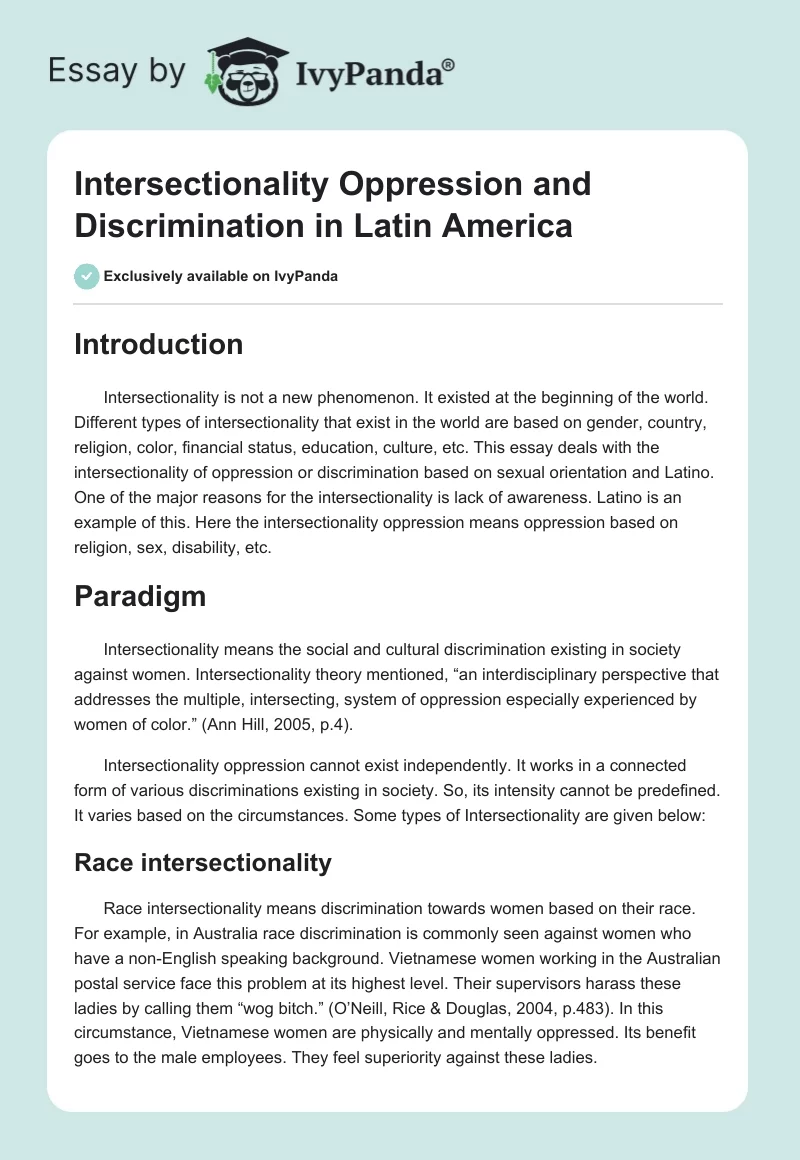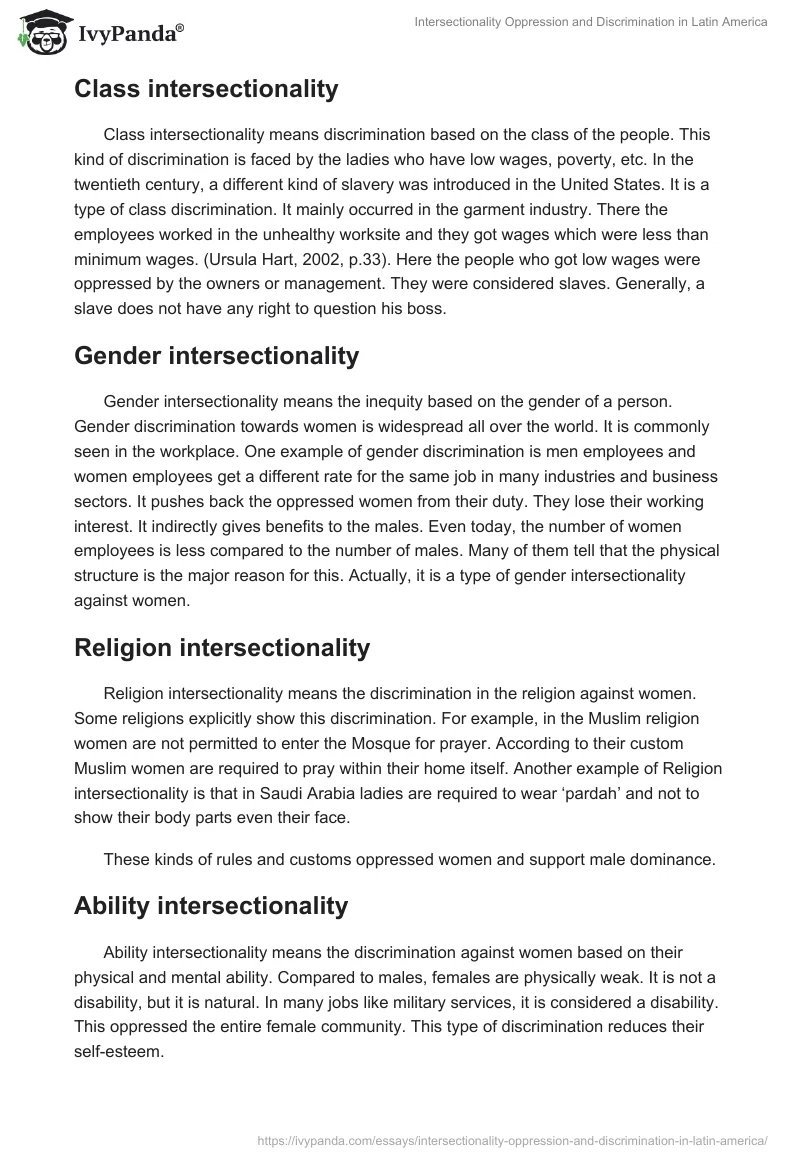Introduction
Intersectionality is not a new phenomenon. It existed at the beginning of the world. Different types of intersectionality that exist in the world are based on gender, country, religion, color, financial status, education, culture, etc. This essay deals with the intersectionality of oppression or discrimination based on sexual orientation and Latino. One of the major reasons for the intersectionality is lack of awareness. Latino is an example of this. Here the intersectionality oppression means oppression based on religion, sex, disability, etc.
Paradigm
Intersectionality means the social and cultural discrimination existing in society against women. Intersectionality theory mentioned, “an interdisciplinary perspective that addresses the multiple, intersecting, system of oppression especially experienced by women of color.” (Ann Hill, 2005, p.4).
Intersectionality oppression cannot exist independently. It works in a connected form of various discriminations existing in society. So, its intensity cannot be predefined. It varies based on the circumstances. Some types of Intersectionality are given below:
Race intersectionality
Race intersectionality means discrimination towards women based on their race. For example, in Australia race discrimination is commonly seen against women who have a non-English speaking background. Vietnamese women working in the Australian postal service face this problem at its highest level. Their supervisors harass these ladies by calling them “wog bitch.” (O’Neill, Rice & Douglas, 2004, p.483). In this circumstance, Vietnamese women are physically and mentally oppressed. Its benefit goes to the male employees. They feel superiority against these ladies.
Class intersectionality
Class intersectionality means discrimination based on the class of the people. This kind of discrimination is faced by the ladies who have low wages, poverty, etc. In the twentieth century, a different kind of slavery was introduced in the United States. It is a type of class discrimination. It mainly occurred in the garment industry. There the employees worked in the unhealthy worksite and they got wages which were less than minimum wages. (Ursula Hart, 2002, p.33). Here the people who got low wages were oppressed by the owners or management. They were considered slaves. Generally, a slave does not have any right to question his boss.
Gender intersectionality
Gender intersectionality means the inequity based on the gender of a person. Gender discrimination towards women is widespread all over the world. It is commonly seen in the workplace. One example of gender discrimination is men employees and women employees get a different rate for the same job in many industries and business sectors. It pushes back the oppressed women from their duty. They lose their working interest. It indirectly gives benefits to the males. Even today, the number of women employees is less compared to the number of males. Many of them tell that the physical structure is the major reason for this. Actually, it is a type of gender intersectionality against women.
Religion intersectionality
Religion intersectionality means the discrimination in the religion against women. Some religions explicitly show this discrimination. For example, in the Muslim religion women are not permitted to enter the Mosque for prayer. According to their custom Muslim women are required to pray within their home itself. Another example of Religion intersectionality is that in Saudi Arabia ladies are required to wear ‘pardah’ and not to show their body parts even their face.
These kinds of rules and customs oppressed women and support male dominance.
Ability intersectionality
Ability intersectionality means the discrimination against women based on their physical and mental ability. Compared to males, females are physically weak. It is not a disability, but it is natural. In many jobs like military services, it is considered a disability. This oppressed the entire female community. This type of discrimination reduces their self-esteem.
Citizenship-based intersectionality
Here the nationality is the base for intersectionality. Migrants face this kind of intersectionality rather than any other category. Immigration and Nationality Act in United State indirectly shows intersectionality based on citizenship. According to this act, a U.S migrant cannot marry a U.S citizen without U.S citizenship.
In the Latino community, sexual discrimination is very high compared to other communities. The term Latino refers to the Latin-American people or people who speak Spanish. It causes a negative impact on that society. Almost all Latino parents do not give any information about the sexual orientation to their children. Black LGBT students suffer due to discrimination based on race and ethnicity. The percentage rate of race discrimination is 16.6 and ethnic discrimination is 3.8 “Almost a quarter of these students experience physical harassment due to their sexual orientation alone, and 13.2% due to both their sexual orientation and race or ethnicity. “(New study reveals Latino parents’ view on bullying, sexual orientation, and prejudice, 2009).
Conclusion
From the above discussion, one can conclude that intersectionality based on color, race, gender, citizenship, religion, etc is existing in the world. It discourages women to enter the mainstream of society, industrial sectors, business sectors, politics, etc. It encourages males more and more. It creates inequality in the world. It is not a good trend. For the development of a world which gives equal status to males and females, intersectionality should be prevented. For this, politicians, the judiciary, social activists, etc. should work together.
Reference
Ann Hill, Shirley. (2005). Black intimacies: A gender perspective on families and relationships. Rowman Altamira. 4. Web.
New study reveals Latino parents’ view on bullying, sexual orientation, and prejudice. (2009). Medical News Today. Web.
O’Neill, Nick., Rice, Simon., & Douglas, Roger. (2004). Retreat from injustice: Human Rights laws in Australia. Federation Press. 483. Web.
Ursula Hart, Mechthild. (2002). The poverty of life affirming work: Motherwork, education, and social change. Greenwood Publishing Group. 33. Web.


